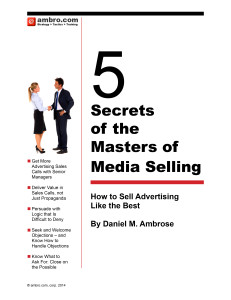What, indeed, makes the world go around? The immutable forces of physics would be one answer. In our more prosaic world, and something I know more about, it’s the creative and destructive forces of the economy.
Every day the sun comes up, it’s a new day of opportunity. New products and services are created displacing the older ones. Fortunes are made or lost. Progress: new products and services replacing older, less effective or efficient ways of doing things.
 How do new products and services get their start? The answer is advertising and sales. That is where you come in: Ad-sales executives make the media world go around. You are the real energy source that drives the economy, helping customers to discover the new products and services that make their life better. You provide the inspiration and tactics to your clients to help them sell something new that no-one knows about.
How do new products and services get their start? The answer is advertising and sales. That is where you come in: Ad-sales executives make the media world go around. You are the real energy source that drives the economy, helping customers to discover the new products and services that make their life better. You provide the inspiration and tactics to your clients to help them sell something new that no-one knows about.
Often you sell a media property that the prospect thinks they don’t need. That is how old media are displaced by new media…the creative destruction that is the hallmark of progress.
In order to sell something the market doesn’t know about, or that customers think they don’t need, cold calls must be made. Cold-calling doesn’t have to be phone-to-phone. It can be walking into a store or office, or walking up to a trade-show booth.
What all cold calls entail is risking — and tolerating — rejection.
Everyone would like it if they didn’t have to make cold calls. But without cold-calls, the economic world would stop turning. Recently the Harvard Business Review published this interesting story on how to overcome the fear of cold-calling. Yes, sales people dislike, even fear, cold calling. In fact I would assert that the line that separates real sales people from everyone else is being able to get over fear of rejection.
Many in the world of advertising-media sales would like to avoid cold-calling. Some would say it doesn’t work. Some say just use social media, others would say use content marketing and lead-nurturing to generate hot leads. These solutions are like diets that promise you don’t have to be hungry to lose weight.
It’s true that in today’s world where business executives don’t answer their phones, and some media buyers don’t listen to their voice-mails. In fact the Coca-Cola Company eliminated voice-mail for a large part of their headquarters staff. But a way must be found to get attention of prospective customers.
But I don’t train sales people to accept mediocrity, nor to take a lack of a returned call as a “no.” Making effective cold-calls is the difference between being average, and standing out. It may be the difference for your company between getting some business and winning enough business to grow, or even to survive.
Let’s be clear what’s cold calling: For our purposes it is the sending of unsolicited, human-personalized, messages to potential prospects. It assumes two things, you can identify target prospects, and they don’t know you or your company.
In a perfect world of ad-sales your company has a marketing campaign to support your cold-calling. It will increase your effectiveness. But good sales people still have to be “happy losers” as explained by a story in the Harvard Business Review years ago: not happy to lose, but happy despite losing a lot. I think of it like baseball hitter who is happy despite being put out 3/4 of the time. A .250 batting average will keep you in the Major Leagues.
Another way to think about cold-calling is to remember that you are in the business of advertising sales. Successful advertising requires frequency. So your cold calls that are not returned are not ‘failure’ but frequency. It takes a lot of frequency to break through into consciousness these days. Your cold calls need to be repeated, high-quality, personalized messages. When they are, the frequency will add to success over time.
Media planners and buyers get a lot of messages about great new media opportunities that are said to be great. They ignore them for any number of reasons, mostly extraneous; they aren’t planning then, they are too busy, they have to run off to pick up their kid from kindergarten. The fact they don’t respond means nothing.
Your repeated, cogent, messages will eventually breakthrough into their interest. Actions speak louder than words. Your actions of calling repeatedly, even acknowledging they you have left messages before and they have not yet been responded to, are the actions that show you really believe your property is right for them and deserves a look and listen. If you don’t believe in your property enough to invest your time in frequency, you probably need to find a different job!
It is true that you will probably make a few sales on the first round. But that won’t make you a star, and may not make your company successful. You need to keep in mind that your prospective customers generally don’t know why they need you. They have been operating without you successfully for some time. So don’t be surprised that the first time, and even the second and third time you reach out, they don’t respond.
Fear of cold-calling comes from fear of rejection. If you don’t think of a non-response, or even a “no” as a rejection, then the calls won’t seem so onerous. When you think of your cold calls — and messages — as an investment in frequency, it will be easier to get down to work. And when you do get an informed “no,” you can file that under a time-saver; you won’t have to call them again allowing you to move on to another prospective account.
More about cold-calling and appointment-getting here:
Not Cold-Calls: A Prospecting Campaign
Start at the Top
Get Serious About Sales Calls
Not Cold Calls, Smart Calls

